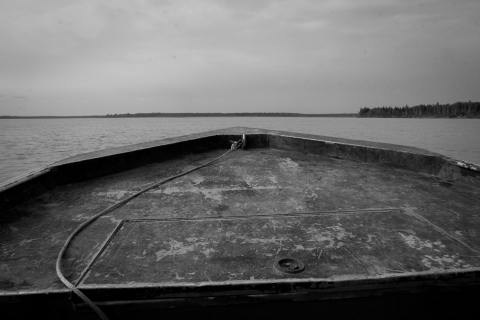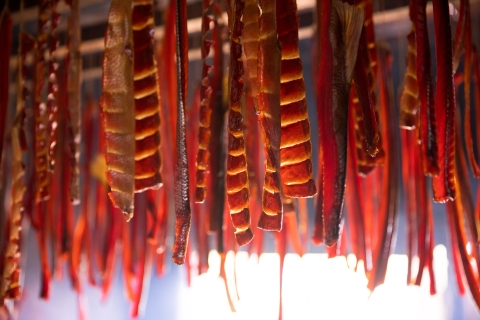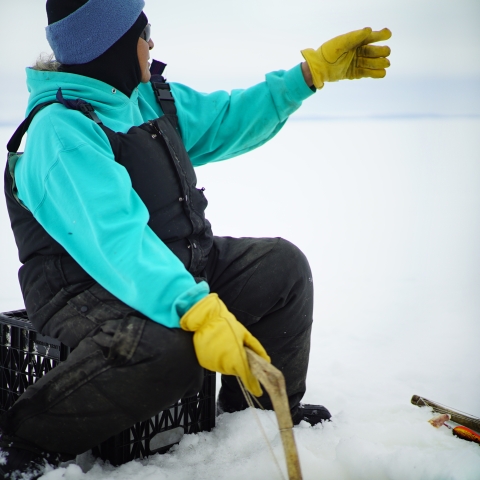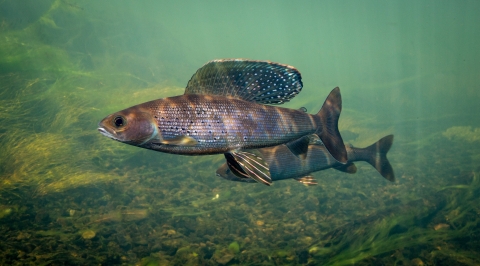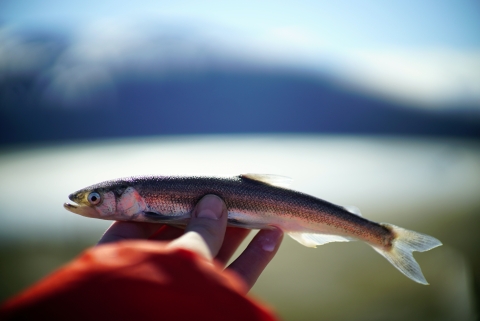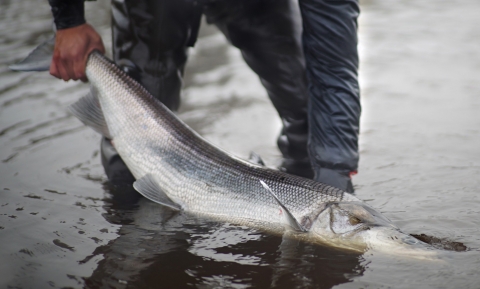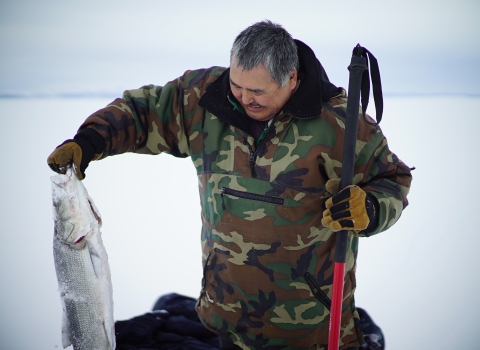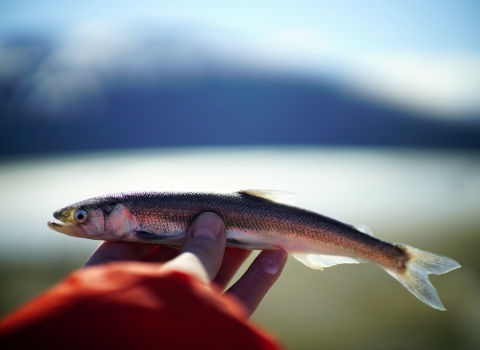To our Tribal guests from Utqiagvik to Curyung, who've shared their Gwichya Gwich'in, Iñupiat, Iñupiaq, Sugpiaq, Athabaskan, Unangax̂, and Tlingit knowledge and perspectives about fish and how they're woven into the fabric of Alaska Native culture, we are so thankful. Our Fish of the Week! podcast celebrates all the fish, and how people are connected to fish. The below episodes showcase the knowledge brought forth by tribal guests speaking about Alaska fishes. We hope you enjoy!
S4:E32 Yukon River Fish Camp
Refuge Information Technician Stanislaus Sheppard speaks about his fish camp and life along Alaska's Yukon River.
"They say subsistence is being taught. It's different compared to actually doing it...Once you experience it, work it, do it, you won't forget. If I sit down and read about subsistence way of life...I know what they're talking about. I don't need to finish reading it. Our elders went through it before them. They found the right way how to live, exact tools to use, how to prepare for winter, how to prepare for the summer...They passed down the knowledge. If my dad didn't teach me how to set net, bring me places to where this is a good place to set net, bird hunting or go out, gather plants, I wouldn't know. Even reading it in the book, I still wouldn't know...We need to pass it down to the younger generation...fight for our salmon, so that the younger generation and their kids could continue living subsistence way of life, not having to depend on the grocery stores or food. Our elders before us lived off the land. They continue living off the land."
<><
S3:E32 Yukon River Chinook: A Gwichya Cwich'in Perspective
Arctic Youth Ambassador Mackenzie Englishoe from Gwichyaa Zhee (Fort Yukon, Alaska) brings her Gwichya Gwich’in perspective about Yukon River Chinook Salmon, fish camp, loss, and the future.
"There's more to it than just the meat. It's a spiritual experience. That fish gave its life to you to help feed you and your family. The ways you would respect the fish is cutting it nicely. And then using every part of the fish. That's a huge one because like the fish gave itself to you, so you shouldn't dispose of anything that you can't use. And then use it to your full ability. After you use the meat or the eggs or the fish head, there are still those salmon bones in there, you can use those salmon bones to make jewelry. So you should respect it and just make sure you use it to your full ability."
"I just really want to see salmon come back to our rivers and for the salmon to be healthy and to strive like they once did. Our elders really miss fish. They were raised on fish. They grew up on fish their whole lives...Fish is something that's in our hearts."
<><
S2:E47 Broad Whitefish: Trade & Table fare
Dried, boiled, or frozen with seal oil, the broad whitefish is a vital table fare here in Alaska. Ernest Nageak from our Utqiaġvik Field Office brings his Iñupiat perspective to the table, while Jason Leppi sheds light on some science surrounding this elusive, migratory fish.
"So they're getting dried whitefish as we speak, under the ice. Right now, when the rivers freeze up, that's when local community members go to the rivers and set fish nets under the ice. So they chop holes, about four or five in a line, and use long hooks to set nets under the ice...They're getting about 90 to a hundred fish a day right now with three nets. 100 foot nets, about four or five feet deep with a four to five inch mesh."
<><
S2:E45 Prince of Wales Island Sockeye Salmon
Head to Prince of Wales Island, Alaska—a temperate rainforest where moss grows thick on giant trees and Sockeye Salmon are the "lifeblood" of this special place. Guests Quinn Aboudara and Andy Stevens bring their perspectives.
"We call it Fish Camp. Growing up, during the summer, our house was always filled with people. We would have my grandmother and my aunts and my uncles and just all sorts of cousins. And we will be laid out on the living room floor and blankets and sleeping bags, just side by side, head to toe. We would bring in the fish. It'd be processed, hung in the smokehouse, jarred, frozen, and distributed out again into the community. Our family has our own little, I guess you could say formula for how we harvest and distribute fish and anything really. But for sockeye we call it 60-20-20...If you catch 100 Sockeye, you pull up to the dock, 60% of that catch goes immediately into your community. It's going to elders, to families in need, to the senior centers, the schools. You take the other 40 and you process it. So you smoke it, you freeze it, you package it, and 20% of that goes into your immediate household. The other 20% is held in reserve. So that is for if there's a big community event, like a wedding, or a funeral or something like a totem pole raising or something of that nature or your community has a tragedy, there's a house fire, so you have that 20% stocked up in reserve. That way you can tap into it in those times of need, so that you can distribute back into the community. And that's kind of how we do it."
<><
S2:E32 Alaska's Wild Salmon: An Unangax̂ Perspective
Maria Dosal, Unangax̂ mother and fisherman from King Cove who now resides in Dillingham shares her perspectives and love for Alaska's wild salmon.
"Salmon are a way of life. As far as cultural importance, Unangax̂ translates in English to sea-sider, basically. And so we grew up on the water. And salmon is just a huge part of that. Our whole year really revolves around the seasons of salmon: harvesting salmon, putting up salmon, eating salmon. It's just magic, really, when the fish are running, it's a magical time and how they keep coming back to us and returning is absolutely incredible."
<><
S1:E50 Jigging for Tomcod (Uuġaq)
Jimmy Evak from Kotzebue, Alaska joins Katrina and Guy to talk about what’s known in his "neck of the tundra" as tomcod/uuġaq. You'll get an audio show-and-tell of Jimmy’s handmade willow jigging sticks, fish he's caught, and learn about the importance of this northern fish to local community members.
"This one I made out of willow. And all it is is just one piece of willow that I either found from the beach, or maybe from something I cut down from the willows when I pass by. I got a little rubber fish and my favorite bait is blubber because when the fish bite it, they can't bite through it. So it's always there. And I can save bait all year round. And the more smellier it gets."
"The people that I know that eat the cod are usually Iñupiaq like me. We eat them raw...a lot of people boil the eggs but myself I like mine frozen raw dipped in seal oil, salt on top."
<><
S1:E48 Fishing Mudsharks with Traditional Traps
Mudsharks! Depending where you live, these bottom-dwelling, single-whiskered fish are also known as burbot, ling, eelpout, cusk, and, in the Kobuk area of Alaska, "Tiktaalik" (the list goes on). Guest Raymond Woods, Iñupiaq Program Coordinator for the Northwest Arctic Borough School District, shares his knowledge about traditional under-ice trapping techniques for this amazing, important fish.
<><
S1:E45 Humpback Whitefish: Athabascan Fish Camp
Get to know the humpback-iest of Alaska's whitefish and local favorite. Guest Travis David from Tetlin National Wildlife Refuge shares his Athabascan perspective and takes Katrina and Guy to fish camp.
"Humpback Whitefish is very high on our Athabaskan food chain. It's one of the main resources that we use for 1000s of years. And we still do it now, to a great degree."
"These locations are connected to our history and our past...where our ancestors used to go..."
<><
S1:E41 Whitefish: Traditional Iñupiaq Fish Trapping
"Traditional foods have been with us from time immemorial. And that's the reason that we're here today."
<><
S1:E27 Arctic Grayling: Fishing with Grandpa
Joanne Bryant (Ditsuh Taii) from Arctic Village, Alaska brings her Gwichʼin/Athabaskan perspectives to talk about Arctic Grayling, culture, and also shares a story about fishing for this spectacular sail-finned beauty with her grandpa.
"My fondest memory was in springtime. My grandpa David used to take us ice fishing up around the bend...Right after school we'd run home and let our parents know we're going ice fishing with Grandpa David. They make sure we were dressed properly and off we went...Once we arrived at the site grandpa had everything ready for ice fishing...We'd sit there for hours fishing quietly listening to the ice cracking and people softly talking and laughing..."
<><
S1:E25 Bristol Bay Sockeyes: An Alutiiq/Sugpiaq Perspective
Orville Lind, from Chignik, Alaska, gives insight into fishing and the cultural importance of Bristol Bay's wild sockeye salmon fishery.
"They go up the river, and they start changing colors. And they get a beautiful bright red with green heads. I mean, the colors are just gorgeous. But you know, it's like the salmon, they provide everything for us...They go to where we live. I mean, how valuable is that? And how respectful is that for that salmon to return to us year after year. And that shows that we have a lot of gratitude and respect for that resource."
<><
S1:E18 Salvation Fish: Eulachon Bring Spring and Fresh Hope
Behold the oily little fish that brings people together each spring. Guests Ted Hart from the Chilkoot lndian Association and Meredith Pochardt from Haines, Alaska bring their perspectives. Read more, or listen:
"The local name I hear a lot is ooligan. It’s like o-o-l-i-g-a-n. And oolichon. Many people say hooligan, and the traditional name for them is saak, s-a-a-k. That’s the Tlingit name."
"You put your net out there and then just use the the current of the river to dip down. And you’re supposed to go “p-o-o-o-o-o-o-”. And that’s a sign of respect for the hooligans. They’re said to be a happy fish. You show your respect, and that you’re happy they’re there."
<><
S1:E8 Dolly Varden of Izembek Refuge
Matt Nielsen joins from Cold Bay / Izembek National Wildlife Refuge in Alaska to talk Dolly Varden and how the rivers can get a little "furry" with bears.
"I grew up here, you know, within a hundred miles stretch of this coast. It's great. I've been fishing here since I can remember. Everyone of all ages joins. I have three kids and we've been dragging them down to the creek since they were born basically."
<><
S1:E6 Sheefish: Ice Fishing Alaska's Largest Whitefish
Siikauraq Martha Whiting of Kotzebue joins Katrina and Guy to talk about sheefish, Alaska's largest whitefish: Sheefish/Inconnu! Learn about fishing through the ice with niksiks made of moose ribs and driftwood and hear about some amazing Alaskan meals and methods of preparation. Read more, or listen:
"That's how we lived for generations. They made their own stuff. You couldn't go to Walmart and buy a fishing pole. People made all their own stuff. You make use of the resources that you have in front of you. People made their own hooks. They use to make them with a little baleen and sinew and ivory. People have to be creative in how we fish. If you don't get food you starve...you die. All this stuff we learned...thank goodness for our elders who taught us how to fish, how to survive...Everybody that I know, they make hand-made jiggers. Hand-made niksiks. You make them either out of wood. You could use a big moose rib. You know, it's kind of curved. You have a handle on one side and you have your line on the other."
<><
Catch new Fish of the Week! episodes every Monday!
We honor, thank, and celebrate the whole community—individuals, Tribes, the State of Alaska, sister agencies, fish enthusiasts, scientists, and others—who have elevated our understanding and love, as people and professionals, of all the fish. In Alaska we are shared stewards of world renowned natural resources and our nation’s last true wild places. Our hope is that each generation has the opportunity to live with, live from, discover and enjoy the wildness of this awe-inspiring land and the people who love and depend on it.


